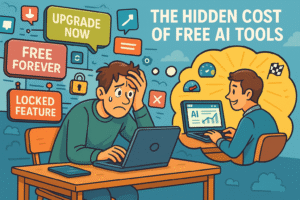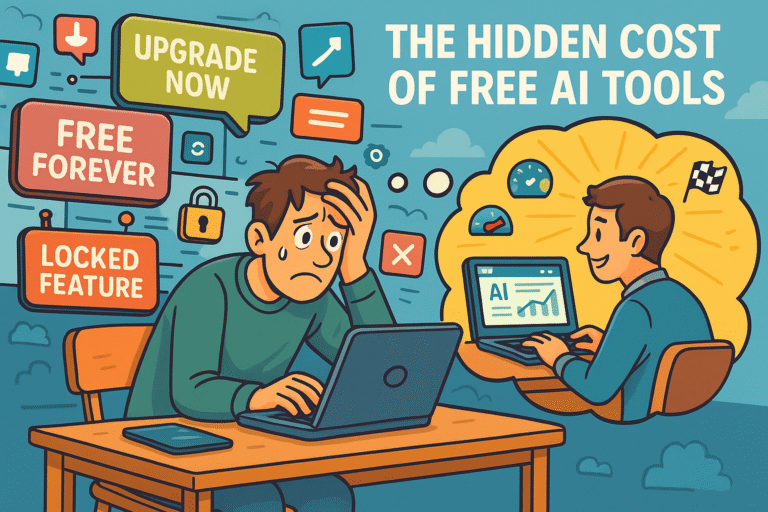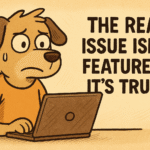Intro
Everyone loves free AI tools. They’re convenient, they’re everywhere, and they promise to help you “scale content” or “automate workflows” without spending a cent.
But here’s the uncomfortable truth nobody talks about:

Most free AI tools are designed to keep you stuck.
They’re good enough to hook you. Just enough to make you feel productive. But never good enough to help you win.
You waste hours working around feature limits, fighting clunky interfaces, and re-editing low-quality output. You convince yourself it’s fine — because hey, it’s free, right?
Wrong. You’re not saving money. You’re burning time, ideas, and momentum. And if you’re a creator, marketer, or entrepreneur — that cost compounds faster than any monthly fee.
This is not an anti-free rant. It’s a wake-up call. Because in 2025, the AI landscape has changed. And clinging to “free forever” tools might just be what’s holding you back the most.
Let’s break down what’s really happening — and how to escape the trap.
TL;DR
-
Free AI tools aren’t really free — they cost you time, quality, and creative energy
-
Most are intentionally limited to nudge you toward a paid upgrade (slowly, painfully)
-
Hidden trade-offs include data harvesting, creative stagnation, and “good enough” output that kills excellence
-
Paid tools like Blaze AI often save money by reducing rework and producing results faster
-
The smartest creators know when to pay — and when to ditch “free” before it drains them
-
Bonus: If you want a roleplay AI that actually gets personal without endless filter blocks, try Candy AI[toc]
Table of Contents
-
Free AI Tools Are Designed to Waste Your Time
-
The Illusion of “Good Enough” Output
-
Feature Gating Is a Productivity Trap
-
You Are the Product: The Data Tradeoff
-
Creative Burnout Is the Real Price Tag
-
Why “Upgrade Nudges” Are Not Bugs — They’re Strategy
-
The Long-Term Cost of Rework and Patching
-
When Free Kills Your Confidence
-
Blaze AI, Candy AI, and the Rise of Tools That Actually Deliver
-
So Should You Ever Use Free AI Tools?
1. Free AI Tools Are Designed to Waste Your Time
Let’s be blunt: these tools are not free. They’re freemium marketing funnels.
Every limitation you hit — the 3-chat-per-day rule, the “Pro Only” watermark, the export block — it’s not accidental. It’s engineered friction. You spend extra hours figuring out workarounds or waiting for a cooldown to lift.
By the time you’re done, you could’ve achieved 3x more with a premium tool. This isn’t theory. It’s happening to thousands of creators daily — and most don’t even realize it.
2. The Illusion of “Good Enough” Output
One of the sneakiest dangers of free AI tools is output complacency. They give you “okay” content. Not excellent. Not viral. Just…okay.
But here’s what no one tells you: “okay” content in a saturated market is the same as failure.
If you’re using AI to write blog posts, scripts, or captions, that output has to stand out. If your tool caps creativity, vocabulary, or tone — you’re not competing. You’re just publishing.
And the longer you tolerate average, the more your audience checks out.

3. Feature Gating Is a Productivity Trap
Let’s say you want to schedule content, create variations, or repurpose a post. On a free AI plan? Good luck.
Almost all powerful features — bulk generation, scheduling, integrations — are locked. You know what that means? You manually repeat tasks that should be one-click.
Want to upload your own brand kit? Pay.
Want long-form memory? Pay.
Want API access? You guessed it — pay.
That friction isn’t just annoying — it’s a productivity tax. Every task you repeat by hand eats into your time, focus, and revenue potential.
4. You Are the Product: The Data Tradeoff
Free AI tools are not funded by kindness. They’re funded by your behavior data.
When you use a free AI writing app, you’re not the customer — you’re the training set. Your prompts, responses, and time-on-site are collected to improve their models or… worse, sold to third parties.
And if you’re inputting sensitive content (strategy docs, client info, DMs), congrats: you’re handing over unpaid labor and private data in exchange for laggy output and capped access.
That’s not just inefficient. That’s reckless.
5. Creative Burnout Is the Real Price Tag
AI was supposed to lighten your creative load. But with most free tools, the opposite happens.
Instead of amplifying your ideas, they force you into a repetitive cycle:
-
Draft
-
Tweak
-
Rewrite manually
-
Try another prompt
-
Give up and start over
That process burns more energy than it saves. And over time, it chips away at your enthusiasm. You stop experimenting. You stop shipping. And eventually, you stop creating altogether.
That’s how “free” breaks your spirit.
6. Why “Upgrade Nudges” Are Not Bugs — They’re Strategy
Every time your tool says “Upgrade to unlock X,” that’s by design. It’s called friction-based conversion — and it works by slowly eroding your patience until you crack.
But the real problem isn’t that you upgrade — it’s when you upgrade.
You often pay after wasting weeks being frustrated and shipping subpar work. Instead of seeing the tool’s best features from the start, you form a negative association with the entire product.
That delay costs you results. And it damages the very habit you were trying to build.
7. The Long-Term Cost of Rework and Patching
Let’s do some rough math.
Say you use a free AI video tool that saves you “$30/month.” But every video it creates needs 45 minutes of manual editing to fix tone, subtitles, or pacing.
Now compare that to a $25/month tool like InVideo AI that delivers polished results in 1/10th the time.
Multiply that across 10 videos. That’s 7.5 hours lost per week — just to avoid a subscription.
You didn’t save money. You traded precision for pain.
8. When Free Kills Your Confidence
Let’s talk psychology.
When your AI assistant keeps making silly errors, ignoring context, or forgetting instructions — you start to blame yourself. You think maybe I’m not prompting right. You lose faith in your ideas.
It’s not you. It’s the tool.
High-quality tools like Candy AI or Blaze AI are designed to understand nuance, respect memory, and stay consistent. That’s what gives you confidence to create at scale — not just tinker.
Free tools rarely offer that. They erode your creative rhythm by turning every project into guesswork.

9. Blaze AI, Candy AI, and the Rise of Tools That Actually Deliver
Let’s give you something actionable.
If you’re tired of juggling 5 different tools and still not getting results, here’s what actually works:
-
Blaze AI: Your all-in-one content OS. Short-form writer, brand kit, repurposing, scheduler — everything works together. No patchwork. No plugin mess.
-
Candy AI: If you’re into roleplay, brainstorming, or late-night existential therapy with bots that actually listen — this one’s for you. No memory wipes. No filters ruining the vibe.
-
Systeme.io: Want funnels, email sequences, and digital product launches all in one tab? This thing replaces 5 tools — and it’s built for speed.
Bottom line: real tools save you more than they cost.
10. So Should You Ever Use Free AI Tools?
Yes — but strategically.
Use free AI tools:
-
To test workflows before committing
-
For non-critical experiments
-
When the output doesn’t affect revenue or reputation
Don’t use them:
-
For client work
-
For publishing at scale
-
For anything that fuels your income
Know the line. And be honest with yourself: are you clinging to “free” because it works — or because it feels safe?
The sooner you upgrade your tools, the sooner you upgrade your output.
And in 2025, average is dead. Only speed, depth, and standout quality will survive.
Conclusion: Free Isn’t the Future — It’s a Funnel
Free AI tools are a brilliant gateway — but a terrible long-term plan.
They’re not built to help you scale. They’re built to remind you what you’re missing.
So if you’re tired of tiptoeing around locked features, broken workflows, or output that barely passes, you have two options:
-
Keep pushing through the mud because it’s free
-
Or finally invest in tools that respect your time, energy, and goals
Your time is more expensive than any subscription. Treat it that way.



